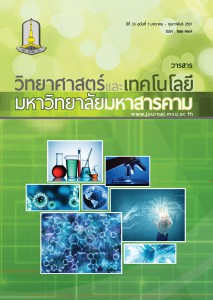ปัจจัยที่มีความสัมพันธ์กับการปวดหลังของอาจารย์มหาวิทยาลัยมหาสารคาม
Main Article Content
Abstract
บทคัดย่อ
การศึกษาครั้งนี้เป็นการวิจัยแบบภาคตัดขวาง (cross-sectional research) โดยมีวัตถุเพื่อศึกษาสภาพปัญหาของการปวดหลังสภาพแวดล้อมในการปฏิบัติงาน พฤติกรรมความปลอดภัย แนวทางป้องกันการปวดหลัง และศึกษาปัจจัยที่มีความสัมพันธ์กับการปวดหลังของอาจารย์มหาวิทยาลัยมหาสารคาม ในกลุ่มตัวอย่างจำนวน 201 คน ทำการสุ่มเลือกตัวอย่างอย่างง่าย เก็บข้อมูลโดยใช้แบบสอบถาม
ผลการศึกษา กลุ่มตัวอย่างมีอาการปวดหลังในระยะเวลา 1 เดือนก่อนเก็บข้อมูลร้อยละ 57.2 เคยมีการอาการปวดหลังเฉลี่ย 5 ครั้งต่อเดือน (ส่วนเบี่ยงเบนมาตรฐานเท่ากับ 10.1) ด้านการรักษาพบว่าส่วนใหญ่ไม่เคยรักษาอาการปวดหลังในช่วง1 เดือน ที่ผ่านมาร้อยละ 87.8 สาเหตุที่ทำให้เกิดการปวดหลังมากที่สุดคือ การนั่งในท่าเดียวนานๆ ร้อยละ 72.9 ส่วนใหญ่มีความรู้สึกว่าเก้าอี้ที่นั่งปฏิบัติงาน มีความสูง ความกว้าง ความลึก และความนิ่ม มีความเหมาะสมระดับปานกลาง และโต๊ะที่ใช้ปฏิบัติงาน ในด้านความสูง ความกว้าง และความลึก มีความเหมาะสมระดับมากและปานกลางใกล้เคียงกัน จากการวิเคราะห์ความสัมพันธ์ระหว่างปัจจัยต่างๆ กับอาการปวดหลังด้วย Logistic regression พบว่าปัจจัยที่มีความสัมพันธ์กับการปวดหลังอย่างมีนัยสำคัญได้แก่ ดัชนีมวลกาย ระดับความเครียด ระดับพฤติกรรมความปลอดภัย และความเหมาะสมของความนิ่มเก้าอี้
โดยสรุป ผลการวิจัยพบว่าอาจารย์เป็นกลุ่มที่เสี่ยงต่อปัญหาการปวดหลัง และมีปัจจัยที่มีความสัมพันธ์ต่ออาการปวดหลังทั้งปัจจัยส่วนบุคคลและสภาพแวดล้อม ดังนั้นควรจัดสภาพแวดล้อมในการปฏิบัติงาน และส่งเสริมพฤติกรรมที่เหมาะสมต่อการป้องกันการปวดหลังต่อไป
คำสำคัญ: ปวดหลัง พฤติกรรมสุขภาพ เก้าอี้ โต๊ะ เออร์กอนอมิกส์
Abstract
The purposes of this cross-sectional research were to study back pain, working environment, safety behaviors, back pain prevention, and study factors associated with back pain among Mahasarakham University lecturers. Two hundred and one Mahasarakham University lecturers were drawn as study samples using simple random sampling. Questionnaires were used for data collection.The study results showed that 57.2% of samples suffered from back pain during the month before undertaking the study. During the month before undertaking the study, the majority of samples (87.8%) had never received any back pain treatments. The samples reported that the main cause related to back pain was sitting for a long time72.9%. When asked about the appropriateness of working chairs, the samples reported that the working chairs’ height, width, depth and softness were at the moderate level of appropriateness. For the depth, height, and width of the working tables were at the moderate and high level of appropriateness with similar rates. When analyzing the factors associated with back pain using logistic regression, the results illustrated that Body Mass Index, stress level, safety behavioral level and the softness of chairs were significantly associated with back pain.
In conclusion, the study results revealed that lecturers were the risk group that suffer back pain due mainly to their individual characteristics and working environmental factors. Therefore, promoting health behavioral activities as well as building healthy working environment at the workplace are reasonably recommended for back pain prevention.
Keyword: back pain, health behavior, chairs, tables, ergonomic


